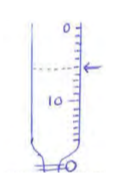KNEC KCSE Physics Paper 1 Question Paper / 2015 KCSE Gem Sub-County Joint Evaluation
PHYSICS PAPER 1 QUESTION PAPER
2015 KCSE Gem Sub-County Joint Evaluation
Physics Paper 1
SECTION A : (25 Marks)
Answer all questions
Figure 1 below shows a burette containing a liquid up to the level marked on the figure. 20 drops of the liquid are now run out of the burette. If each drop has a volume of 1.1ml. Mark on the figure the new level of the liquid in the burette.
2 marks
Figure 2 below shows a glass tube dipped in water inside a trough. The cross sectional area of the tube is 2cm2
Determine the adhesive force between water and glass. (Take density of water = 1000kgm-3, acceleration due to gravity = 10ms-2)
3 marks
Figure 3 below shows a velocity-time graph for a body.
Fig 3
Describe the motion of the body between A and B.
1 marks
Give a reason why mercury is preferred for use in a thermometer.
1 marks
Figure 4 shows a U-tube connected to gas supply containing liquids L1 and L2 of densities 1.8gcm-3 and 0.8gcm-3 respectively in equilibrium.
Given that h1 = 8cm, h2 = 10cm and atmospheric pressure is 1.02 x 105
Pa. Determine the gas pressure.
3 marks
Explain why gases have larger intermolecular distances than solids.
1 marks
Figure 5 below shows two balloons containing two different gases suspended on a rod. The set up is in equilibrium.
When the set up is moved in hot sun the system tips to the right.
a) Compare expansivity of the gases A and B. (1 mark)
b) Explain your answer to (a) above. (2 marks)
3 marks
Figure 6 below shows an oil patch formed on water surface laced with lycopodium powder.
Given that the patch was from one drop of oil whose volume was 31.42mm3. Determine the size of one molecule of the oil.
3 marks
State one similarity between “moment of force about a point” and “work done”
1 marks
Figure 7 below shows a log of wood 2m long lying on a flat ground. Two forces F1 and F2 applied at the ends of the log will just lift the log while maintaining horizontal position.
Determine :
a) the weight of the log (1 mark)
b) the perpendicular distance from the centre of gravity of the log to force F2 (2 marks)
3 marks
The table below shows the results carried out to study properties of a spring.
a) In the space below, sketch a graph of extension against load. (1 mark)
b) Determine the elastic constant of the spring. (2 marks)
3 marks
Figure 8 below shows a tube of varying cross-sectional area fitted with narrow tubes of uniform cross-sectional areas h1, h2, h3 and h4 represent the heights of water column as the water flows in the tube at varied speeds. Arrange the heights h1, h2, h3 and h4 in increasing order starting with the lowest.
1 marks
SECTION B : (55 Marks)
Answer all questions.
a) On a certain planet a simple pendulum of length 0.5m oscillates with a frequency of 1.25Hz. If the mass of the body suspended on the body is 50g.
Determine :
i) the acceleration of gravity on the planet (2 marks)
ii) the weight of the body on the planet (2 marks)
b) Figure 9 below shows two connected bodies of masses 0.5kg and 50g joined by a light
inextensible string passing over a smooth pulley. When released, the 0.5kg mass moves a distance
of 0.6m before coming to rest. The coefficient of friction between the 50g mass and the table is 0.3
i) Determine :
I. the tension on the string. (2 marks)
II. the acceleration of the 0.5kg mass. (2 marks)
ii) Find the velocity of the 0.5kg mass just before hitting the ground. (3 marks)
11 marks
a) State two factors that must be kept constant for a gas to obey Boyle’s law. (2 marks)
b) An air bubble rises from the bottom of a pond 20m deep until it reaches the top of the pond. The
graph below shows variation of pressure exerted on the bubble with volume of the bubble.
i) From the graph, determine the pressure exerted on the bubble and volume of bubble at
I. the bottom of the pond (2 marks)
II. the top of the pond (2 marks)
ii) Explain the shape of the graph. (2 marks)
iii) Determine the atmospheric pressure at the place of the experiment. (2 marks)
iv) Sketch in the space below the graph of pressure against reciprocal of pressure for the bubble. (2 marks)
10 marks
a) Apart from the definitions, distinguish between temperature and heat. (1 mark)
b) Figure 10(a) below shows variation of volume of water and temperature as water is heated from 0o
C to 40o
C
i) State the value of P (2 marks)
ii) In figure 10(b) below, sketch the graph of density of water against temperature upto 10o
C. (1 mark)
iii) A heater rated 300W was used to heat the water from 0o
C to 40o
C. If the heating took 5 minutes
Determine :
I. the heat supplied by the heater. (3 marks)
II. the heat capacity of the water. (3 marks)
III. the mass of the water (specific heat capacity of water is 4.2KJkg-1k-1) (3 marks)
10 marks
Figure 11 below shows a cylinder of mass 300g.
Kerosene of density 800kgm-3 is poured into the cylinder and the cylinder is made to float on liquid L. It is found that the
cylinder sinks with half its height sunk in liquid L. Kerosene rises in the cylinder to a height of 5cm.
Determine :
a) the weight of the empty cylinder. (3 marks)
b) the upthrust experienced on the cylinder and its contents. (4 marks)
c) the density of liquid L (3 marks)
10 marks
a) State what provides centripetal force for an electron moving round the nucleus. (1 mark)
b) Figure 12 below shows a turn table on which a mass of 50g is placed 10cm from the centre.
Frictional force between the 50g mass and the turn table is 0.4N. When the turntable is made to rotate with angular velocity of
ω rads-1 the mass must starts to slide off.
i) Determine the :
I. angular velocity ω (3 marks)
II. time taken to make one complete revolution (3 marks)
ii) On the figure draw a path that would be taken by the 50g mass if the turntable suddenly came to a stop. (1 mark)
c) Figure 13 below shows a balloon held under water in a container by a string tied to the bottom of the container.
Explain the change in the value of the tension T, as the water gets heated. (3 marks)
10 marks






